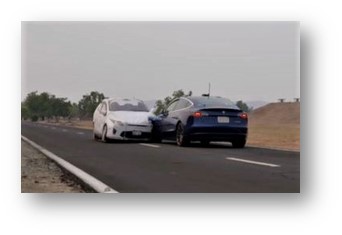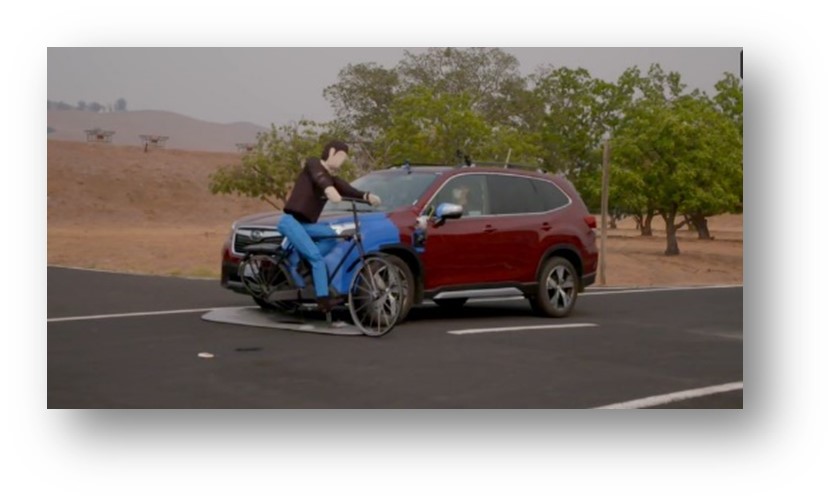PORTLAND, Ore., – New research from AAA shows drivers overwhelmingly want automakers to improve the performance of existing driver assistance technologies rather than develop self-driving cars. And this view is backed by another round of AAA testing that shows these technologies don’t work consistently and can result in crashes with other vehicles and bicyclists.
Here are links to Testing b-roll and the full report.
Consumers surveyed told AAA they are more interested in improved vehicle safety systems (77%) versus self-driving cars (18%).
New testing by AAA finds that driving assistance systems have spotty performance which can result in crashes with other vehicles and bicyclists. Testing done by AAA’s automotive engineering team found that vehicles equipped with an active driving assistance system (also known as Level 2 systems as defined by SAE) failed to consistently avoid crashes with another car or bicycle during 15 test runs. A foam car similar to a small hatchback and a bicyclist dummy was used for this testing. The failures occurred regardless of vehicle make and model. It is the third time AAA has studied these systems’ performance.

A head-on collision occurred during all 15 test runs for an oncoming vehicle within the travel lane. Only one test vehicle significantly reduced speed before a crash on each run.
- For a slow lead vehicle moving in the same direction in the lane ahead, no collisions occurred among 15 test runs.
- For a cyclist crossing the travel lane of the test vehicle, a collision occurred for 5 out of 15 test runs, or 33% of the time.
- For a cyclist traveling in the same direction in the lane ahead of the test vehicle, no collisions occurred among 15 test runs.
The research vehicles performed as expected during the closed-course testing for routine situations, such as approaching a slowing moving vehicle or bicyclist from behind. However, all test vehicles collided with either the simulated passenger car or the adult cyclist multiple times during “edge-case” testing, like a car approaching head-on or a bicyclist crossing directly in front of the test car. This reinforces recent AAA research calling for direct driver monitoring systems with camera-based technology to be integrated into active driving assistance systems.
 “It’s alarming that most of these driver assistance technologies can often fail, resulting in collisions with other vehicles or a bicyclist. The new AAA research shows that until these systems improve, drivers can’t rely on them. So drivers need to remain alert and continuously engaged whenever they’re behind the wheel,” says Marie Dodds, public affairs director for AAA Oregon/Idaho.
“It’s alarming that most of these driver assistance technologies can often fail, resulting in collisions with other vehicles or a bicyclist. The new AAA research shows that until these systems improve, drivers can’t rely on them. So drivers need to remain alert and continuously engaged whenever they’re behind the wheel,” says Marie Dodds, public affairs director for AAA Oregon/Idaho.
Active driving assistance systems are widely available on most newer vehicles and often called semi-autonomous because they combine vehicle acceleration with braking and steering. Since 2016, AAA has surveyed consumers about driving assistance systems and self-driving cars to track sentiment regarding emerging vehicle technology.
Key findings in the latest round of AAA research show that while consumer interest in driving assistance vehicle technology remains steady, there is more interest in familiar features that consumers perceive to be designed for their safety, such as automatic emergency braking.
Meanwhile, consumer distrust of fully self-driving vehicles remains high. AAA found 85% are fearful or unsure of self-driving technology, a level that has remained steady for the past several years. When transporting their children or loved ones, 85% also said they would not be comfortable with using a self-driving vehicle.
A troubling belief in commercially available self-driving cars was also revealed in the data, with 12% incorrectly thinking they could buy such a vehicle while 53% were unsure if they could.
Previously, AAA found that active driving assistance systems failed to maintain lane position in real-world conditions consistently and had other challenges in closed-course testing. To see the details of these previous research projects, please visit the AAA Newsroom.
Consumer Survey Methodology
The AAA consumer survey was conducted on January 13-16, 2022, using a probability-based panel to represent the U.S. household population overall. The panel provides sample coverage of approximately 97% of the U.S. household population. Most surveys were completed online; consumers without Internet access were surveyed over the phone. A total of 1,107 interviews were conducted among U.S. adults 18 years of age or older. The margin of error for the study is 4% at the 95% confidence level.
Vehicle Testing Methodology
Closed course testing occurred at AAA Northern California, Nevada, and Utah’s GoMentum Station proving ground in Concord, California. Using a defined set of criteria, AAA selected the following vehicles for testing: 2021 Subaru Forester with “EyeSight®,” 2021 Hyundai Santa Fe with “Highway Driving Assist,” 2020 Tesla Model 3 with “Autopilot” and were sourced from the manufacturer or specialty rental fleets. Please refer to the full report for specific methodology regarding testing equipment and closed-course test scenarios.
About AAA
Started in 1902 by automotive enthusiasts who wanted to chart a path for better roads in America and advocate for safe mobility, AAA has transformed into one of North America’s largest membership organizations. Today, AAA provides roadside assistance, travel, discounts, financial and insurance services to enhance the life journey of 62 million members across North America, including 56 million in the United States. To learn more about all AAA offers or become a member, visit AAA.com.
AAA news releases, high resolution images, broadcast-quality video, fact sheets and podcasts are available on the AAA NewsRoom at NewsRoom.AAA.com.
Find local news releases at https://oregon.aaa.com/community/media/media-contacts.html

